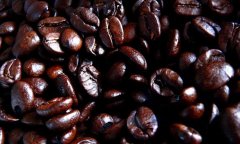Is the coffee more fresh and delicious? Do oiled coffee beans have more calories? is it suitable for Italian hand flushing?
Is the coffee bean oil more fresh and delicious? Do oiled coffee beans have more calories? is it more suitable for Italian style or hand flushing? Let Qianjie answer your questions and questions today.

Myth 1: oiled coffee is more fresh.
Equating oily with fresh seems like a smart way to bake coffee, doesn't it? When beans have that luster, they look very shiny and sexy! However, this is not a foolproof way to judge whether coffee has been kept for a period of time, because dark-roasted beans naturally show more oil faster than light-roasted beans. Decaffeinated also tends to be a bit tricky: seeds tend to have weak cellulose because of the trauma they suffer in the decaffeinated process. ) your best way is to find a baking date on the beans, because there is no perfect equation to calculate how much oil may appear in a certain amount of weeks or even months.
Myth 2: coffee oil is part of what makes coffee delicious.
Like any oil, prolonged exposure to light and oxygen (and heat) can produce rancid odors and odors, so if oil is the result of stagnant coffee sales, it will never contribute to the delicacy of the cup. It also means that you should be especially careful with your deep-baked foods: storing them in a cool, dark place will be the best way to prevent them from going bad.
Myth 3: the coffee extracted from oily beans has a higher fat content.
Because oil is insoluble in water, most extraction methods leave lipids, especially in the filter cup of hand-brewed coffee. According to a 2006 report by Karl Speer and Isabelle K ö lling-Speer, "the lipid portion of coffee beans": "filtered coffee prepared using an ordinary household coffee mechanism has a lipid content of less than 0.2 per cent. By contrast, in the preparation of espresso, 1% to 2% of lipids. From finely ground espresso into the drink. "
Paper filters are thought to be much more efficient in retaining and absorbing coffee oil during brewing, while perforated or reticulated metal (such as in a portable filter basket on an espresso machine, or a screen on a French filter press) has larger pores and therefore allows more oil to pass through the final drink.

However, this mainly means that espresso (or French filter press) tastes heavier or more creamy-not necessarily because the coffee itself is much higher in calories or fat. Filtered brewed coffee may contain 1 to 3 calories per 8 ounce serving, while each 2 ounce serving of espresso contains about 5 calories, mainly due to the amount of oil allowed into the finished drink. Consider that the consistency of espresso comes from filtered coffee with a lower concentration. )
Important Notice :
前街咖啡 FrontStreet Coffee has moved to new addredd:
FrontStreet Coffee Address: 315,Donghua East Road,GuangZhou
Tel:020 38364473
- Prev

Why do coffee beans produce oil? roast coffee beans? what do you mean by two explosions? how to judge the tipping point?
Roasting coffee beans is really a magical thing: throw some humble green seeds into a hot environment, and in less than 15 minutes (or about), they will become magical beans, grind and add some hot water to become a delicious and healthy coffee drink. If we think about it carefully, we will know that a lot of changes have taken place inside the coffee beans in this process. Although there is a promise
- Next

What is the Q-GRADER examination course Q Certification helps the sense of Coffee to correct the Taste of Q Certificate
Some people know better than others how to evaluate the quality of raw coffee. These people are Q Graders, who have passed the rigorous training of the Coffee quality Research Institute. This is a specific training, and the whole field of research will eventually add value to the starting point of the coffee value chain. Through Q Arabica and Q Robusta,Q programs have become trade tools for coffee around the world
Related
- Detailed explanation of Jadeite planting Land in Panamanian Jadeite Manor introduction to the grading system of Jadeite competitive bidding, Red bid, Green bid and Rose Summer
- Story of Coffee planting in Brenka region of Costa Rica Stonehenge Manor anaerobic heavy honey treatment of flavor mouth
- What's on the barrel of Blue Mountain Coffee beans?
- Can American coffee also pull flowers? How to use hot American style to pull out a good-looking pattern?
- Can you make a cold extract with coffee beans? What is the right proportion for cold-extracted coffee formula?
- Indonesian PWN Gold Mandrine Coffee Origin Features Flavor How to Chong? Mandolin coffee is American.
- A brief introduction to the flavor characteristics of Brazilian yellow bourbon coffee beans
- What is the effect of different water quality on the flavor of cold-extracted coffee? What kind of water is best for brewing coffee?
- Why do you think of Rose Summer whenever you mention Panamanian coffee?
- Introduction to the characteristics of authentic blue mountain coffee bean producing areas? What is the CIB Coffee Authority in Jamaica?

